Soil Acidification: Measure & Manage
Acidity assessment
- Look for unexplained poor health generally in low or mid-slope areas. Plants affected
by aluminum toxicity have club shaped roots (Figure 1). For more photos go to our
Nutrient Deficiency and Toxicity webpage.
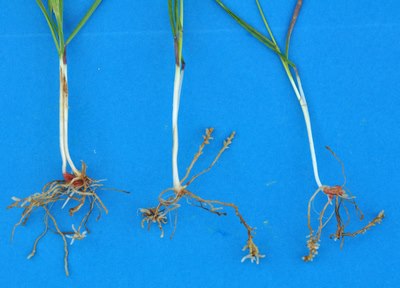
Figure 1. Club shaped roots on durum wheat caused by aluminum toxicity.
- Test a soil/water slurry at the 2- and 4-inch depth with a pH meter stick/probe (for digital reading, rather than color strips) where low pH is suspected. If soil pH < 5 at either depth then soil acidity is likely a concern. Soil pH tests to calculate lime rates should be on well-mixed 6-inch deep samples. See Soil Acidification: Problems, Causes & Soil Testing for more information.
- Look at standard soil tests for composited soil from a field in the top 6 inches. If pH < 6 it is likely the field will have spots close to or below pH 5. If pH > 6, don't assume there are no areas with low pH.
- Soil test top 3 inches from affected regions for KCl extractable aluminum (Al). If Al > 5 ppm then soil acidity is likely a concern.
- Compare manganese (Mn) tissue analysis from 'good' and 'bad' crop areas. Tissue Mn > 500 ppm is likely a problem (Ohki 1984) . Aluminum does not translocate very well from roots to shoots, so shoot tissue analysis for Al is not worthwhile. Also, since acid tolerant crop varieties have lower leaf Al concentrations than acid sensitive ones, it is difficult to provide critical concentration levels for a crop (Foy 1996).
- Dr. Amber Moore's WERA-103 presentation on the ins and outs of soil pH and buffer pH testing
Manage low pH
Tools and steps for remediation, adaptation and prevention are detailed in other materials listed on our Resources page.
Lime
Based on the MSU studies, you can use one of the following two methods to determine lime rates:
- Ask a lab to use the modified Mehlich buffer test to determine buffer pH and liming needs. Watch The Ins and Outs of Soil pH and Buffer pH Testing for more information.
- See Soil Acidification: Remediation with Sugar Beet Lime, Fertilizer eFact No. 80 for liming rates with spent sugar beet lime. Or use 0 to 6-inch soil pH values and
this equation (Engel unpub. data) to estimate lime requirements. Lime rate (CaCO3 ton/acre) = 1.5 x (desired pH increase)
- Sugar beet lime and most aglime must be incorporated with tillage (e.g., 4-5 inches with beavertail spike and harrow, or tandem disc harrow) to be effective. It does not move into the soil with rain in dryland conditions.
-
The single tillage used to incorporate sugar beet lime did NOT reduce soil organic carbon (SOC) in the top 8-inches of soil a year after tillage (Figure 2).
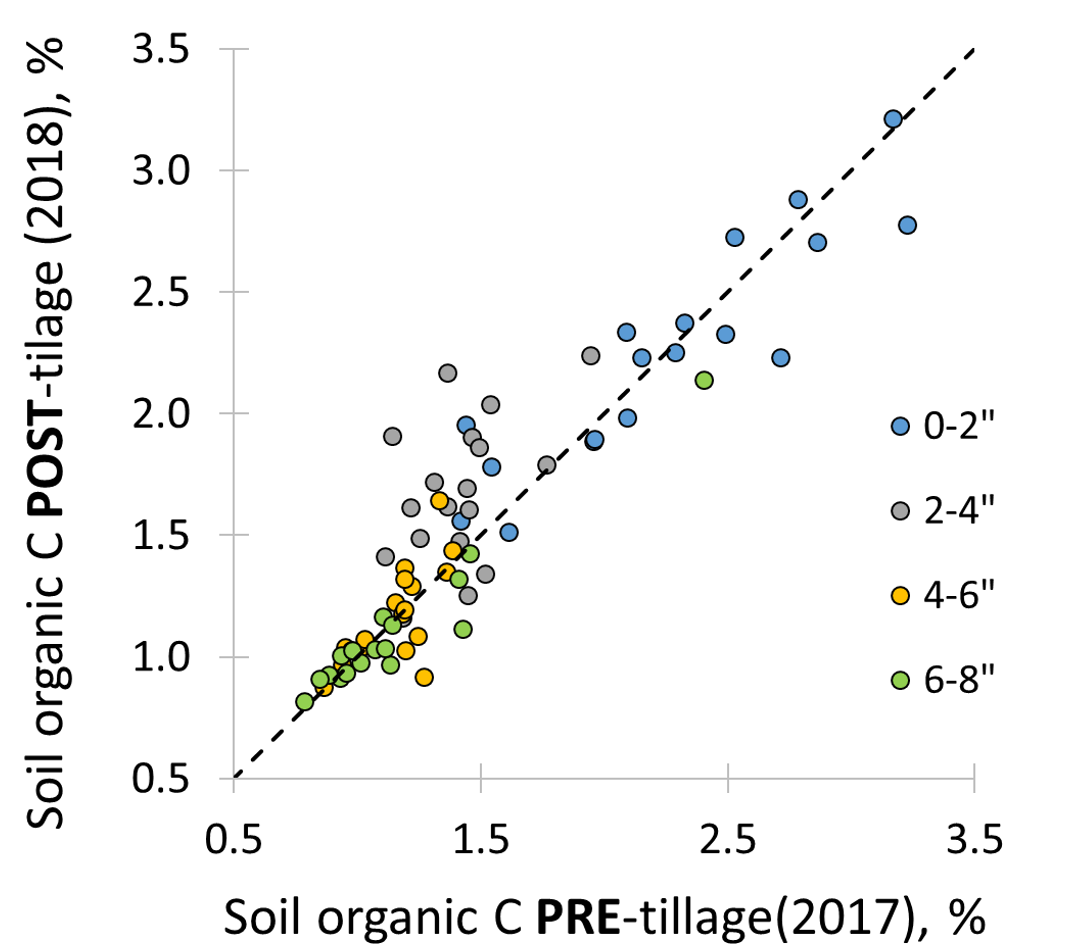
Figure 2. Soil organic carbon before 4-5" tillage to incorporate sugar beet lime, and a year later, by soil depth. Fort Benton and Geraldine, MT, sites (Engel unpub. data).
- A review (Blanco-Canqui & Wortmann 2020) of occasional tillage (aka, limited, conservation,
strategic, minimum, targeted) used to address no-till challenges found:
- Effect of tillage depends on tillage method, depth, timing, soil temp and water content at time of tillage.
- Soil organic carbon was not decreased, but there was less vertical stratification of SOC and nutrients.
- Soil water content and aggregation were not generally reduced.
- Where occasional tillage did affect soils and crops, the impacts generally lasted less than 2 years.
Sugar beet lime increased soil pH (Figure 3) and crop yields within 2 years after application (Figure 4). Based on the rate of acidification that occurs with suggested ammonium-based N fertilization rates (Figure 6A), yield benefits should last about 15 years (Rick Engel, unpub. data).
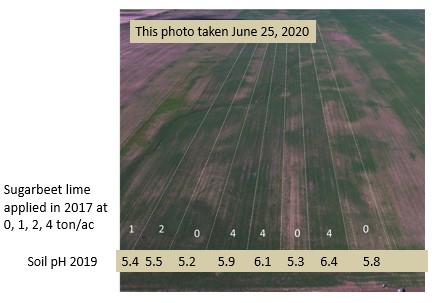
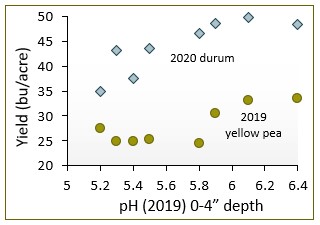
Figure 4. Pea and durum yields by soil pH 2- and 3-years after SB lime application (Rick Engel, unpub. data).
Other Management Options
- Seed-place phosphorus fertilizer can increase small grain yields by reducing aluminum toxicity in a given growing season.
- Consider planting small grain species or varieties that are aluminum or low-pH tolerant (Table 1).
- Consider low-pH tolerant perennials (Table 2).
-
Ammonium-based fertilizer causes soil acidification, even when used at rates within research-based guidelines (Figures 5, 6A, 7). Including legumes in rotation reduces N-fertilizer input and soil acidification (Figures 5, 6B), while perennials can slowly reverse soil acidification.
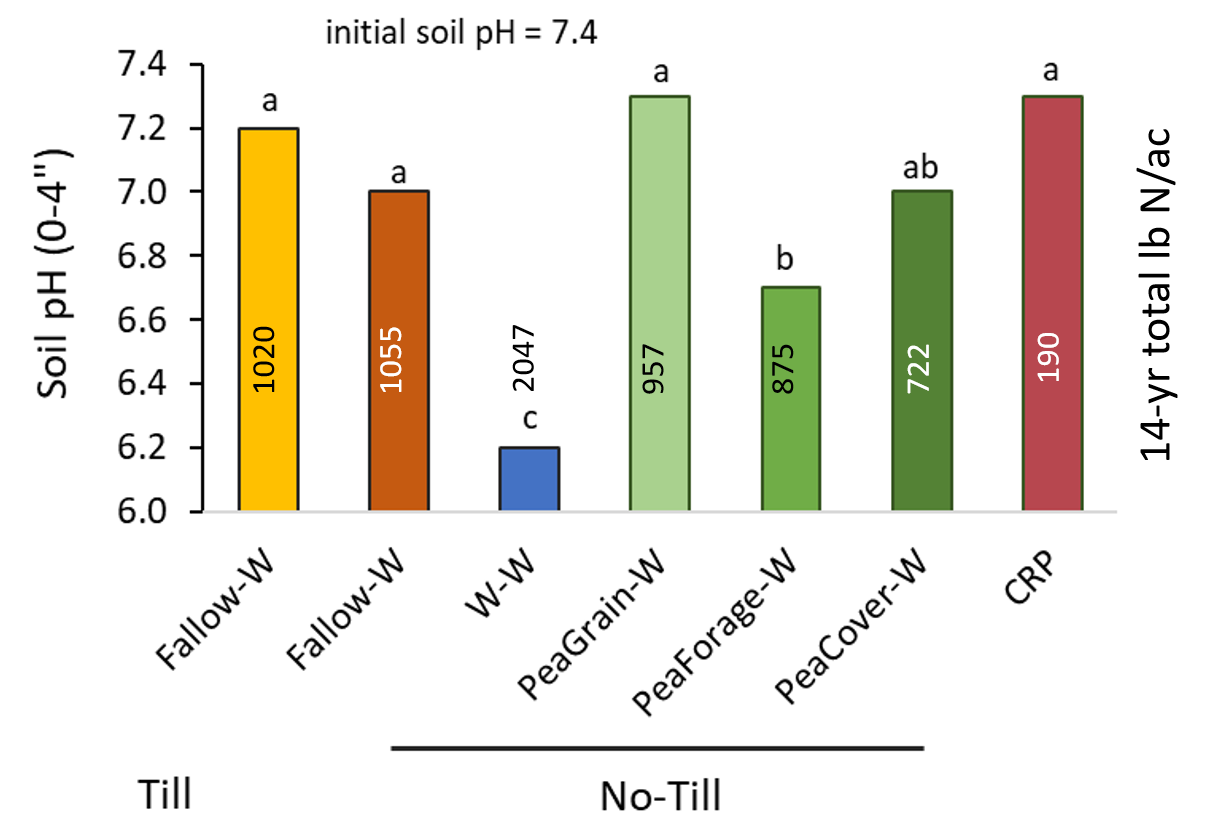
Figure 5. Soil pH after 14 years of N fertilization at recommended rates in different cropping rotations in Gallatin Valley, MT. On average, 100 lb N/ac caused pH to drop by 0.044 units (Engel et al. unpub. data).
- Take steps to increase N fertilizer use efficiency, reduce N rates when possible, keep plant stubble on the field, and include legumes, crops with low N requirements, and perennials in rotation. Prevention is preferred over liming.


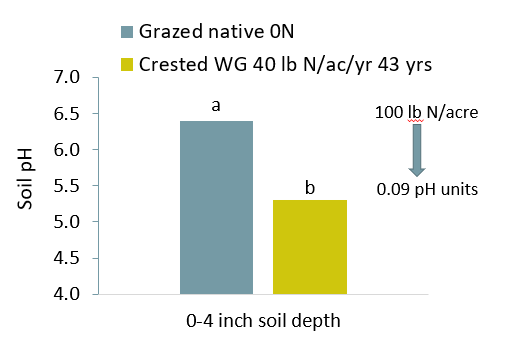
|
Winter wheat variety
|
Years in highest yielding category/site-years planted1.
|
Spring wheat variety
|
Years in highest yielding category/site-years planted1.
|
Year high Al tolerant/site-years2.
|
|---|---|---|---|---|
|
SYMonument SYClearstone2CL Judee Warhorse
|
3/3 4/5 2/3 3/5 |
Egan Reeder McNeal Alum Sy Rockford LCS Dual Lanning Duclair Choteau Carlson Corbin Oneal WB 9879 CLP NS PresserCL+ SyIngmar LCS Hammer AX |
3/3 2/3 ng 2/2 ng ng 3/4 ng 2/3 ng ng 2/3 ng 4/5 2/2 ng |
2/2 4/4 4/4 2/2 3/3 2/2 3/4 3/4 2/3 2/3 2/3 ng 2/3 1/4 0/4 1/4 |
|
1. Varieties tested by the Central Ag. Experiment Station, on the station or the Highwood Bench, MT, yielding same as the highest yielding variety in soil pH near 4.5 (2016, 2017, 2018). 20 winter wheat and over 24 spring wheat varieties were grown. Not all varieties were grown in each location each year. Barley: There was high variation between malting barley yields in 2016 and 2017. None were significantly higher yielding than others in either year. 10WA.107.43 was first grown in 2018 and out-yielded the other varieties by 5 bu/ac on one low pH soil field but not another. Canola: Canola yields are sensitive to soil pH. There were no outstanding varieties on both Highwood bench sites with low pH soil in 2018. On low pH soil, top producing varieties (HyCLASS and DKL 70-10) yielded no greater than the average. 2. Varieties grown on a low pH, high Al site by Rockford, WA. Information courtesy Washington State University Variety Testing Program. |
|
|||
| Common name | Scientific name | Cultivar(s) | Acid tolerance1 | Suitable sites |
Native (N) Introduced (I) |
|---|---|---|---|---|---|
| Perennial grasses observed to be good to excellent on at least one acidic agricultural soil in MT. *variety observed. | |||||
|
brome, meadow |
Bromus biebersteinii |
Cache*, Fleet*, Regar, Paddock |
Marginal – Excellent |
|
I |
|
orchardgrass |
Dactylis glomerata |
Paiute*, Pennlate* |
Fair - Excellent |
|
I |
| wheatgrass, intermediate |
Thinopyrum intermedium |
Oahe*, Reliant, Manifest, Rush* | Marginal - Excellent | I | |
| wheatgrass, slender | Elymus trachycaulus | Copperhead, Pryor*, Revenue | Marginal - Good | Dry | N |
|
wheatgrass, western |
Pascopyrum smithii |
Rosana*, Rodan |
Marginal - Good |
|
N |
|
wheatgrass, hybrid |
Elytr. repens x Pseudo. spicata |
NewHy* |
Good | I | |
| Perennial grasses’ acid tolerance based in part on performance in mine-land reclamation site soils. Some of these may not be competitive in species mixes with aggressive introduced species. | |||||
| bentgrass, creeping | Atrostis stolonifera | Good | Moist | I | |
| bentgrass, redtop | Agrostis gigantea | Good | Moist | I | |
| bluegrass, big | Poa secunda spp. ampla | Sherman | Marginal - Excellent | N | |
| bluegrass, Canby | Poa secunda spp. canbyi | Canbar | Poor - Good | N | |
| bluegrass, Kentucky | Poa pratensis | Marginal - Excellent | I | ||
| bluegrass, Nevada | Poa secunda spp. nevadensis | Opportunity | Good | Dry | N |
| bluestem, little | Schizachyrium scoparium | Badlands, Blaze | Average-Excellent | N | |
| brome, fringed | Bromus ciliatus | Good | Dry | N | |
| brome, smooth | Bromus inermis | Average-Good | Dry | I | |
| fescue, hard | Festuca brevipila | Durar | Average-Good | I | |
| fescue, sheep | Festuca oviina | Covar | Average-Good | Dry | I |
| foxtail, creeping | Alopecurus arundinaceus | Garrision, Retain | Average | Moist | I |
| foxtail, meadow | Alopecurus pratensis | Average | Moist | I | |
| hairgrass, tufted | Deschampsia cespitosa | Excellent | Moist | N | |
| switchgrass | Panicum virgatum | Dacotah, Forestburg | Good-Excellent | Dry | N |
| timothy | Phleum pratense | Average-Good | I | ||
| wheatgrass, beardless/bluebunch | Pseudoroegneria spicata | Whitmar, Goldar, Anatone, P7 | Poor-Fair | Dry | N |
| wheatgrass, streambank | Elymus lanceolatus spp. riparium | Sodar | Poor-Good | N | |
| wheatgrass, tall | Thinopyrum ponticum | Alkar, Jose | Poor-Fair | I | |
| wheatgrass, thickspike | Elymus lanceolatus spp. lanceolatus | Critana, Bannock | Poor-Good | N | |
| wildrye, Altai | Elymus angustus | Poor-Good | I | ||
| wildrye, basin | Elymus cinereus | Trailhead, Washoe | Poor-Good | Dry | N |
| wildrye, Canada | Elymus canadensis | Mandan | Average-Good | N | |
| Biennial or short-lived perennial | |||||
| ryegrass | Lolium multiflorum | as nurse or cover crop | I | ||
| Forbs / Legumes2 | |||||
| alfalfa | Medicago sativa | Marginal-Fair | I | ||
| birdsfoot trefoil | Lotus corniculatus | Leo, Empire | Average-Good | I | |
| clover, red | Trifolium pratense | Marginal-Good | I | ||
| clover, white | Trifolium repens | Marginal-Good | I | ||
| flax, Lewis | Linum lewisii | Appar, Maple Grove | Marginal-Fair | N | |
| sweetclover, yellow or white | Melilotus officinalis, M. alba | Marginal-Good | I | ||
| penstamone, fuzzytongue | Penstemon eriantherus | Old Works | Average | dry | N |
| silverleaf phacelia | Phacelia hastata | Stucky Ridge | Good | dry | N |
|
1Range of acid tolerance from NRCS, MSU, farmer trial, and seed vendor resources. 2N fixation is greatly reduced in soils with pH below 5.5. Plants may need fertilizer N in low N soils. |
|||||
References cited:
Blanco-Canqui, H., and C. Wortmann. 2020. Does occasional tillage undo the ecosystem services gained with no-till? A review. Soil & Tillage. 198:104534 doi:10.1016/j.still.2019.104534
Foy, C.D. 1996. Tolerance of durum wheat lines to an acid, aluminum-toxic subsoil. J. Plant Nutr. 19:10-11. doi:10.1080/01904169609365206
Liebig, M., S. Kronberg, J. Hendrickson, and J. Gross. 2014. Grazing management, season and drought contributions to near-surface soil property dynamics in semiarid rangeland. Rangeland Ecol. Manage. 67:266-274. DOI: 10.2111/REM-D-13-00145.1
Ohki, K. 1984. Manganese deficiency and toxicity effects on growth, development, and nutrient composition in wheat. Agron. J. 76:213–218
